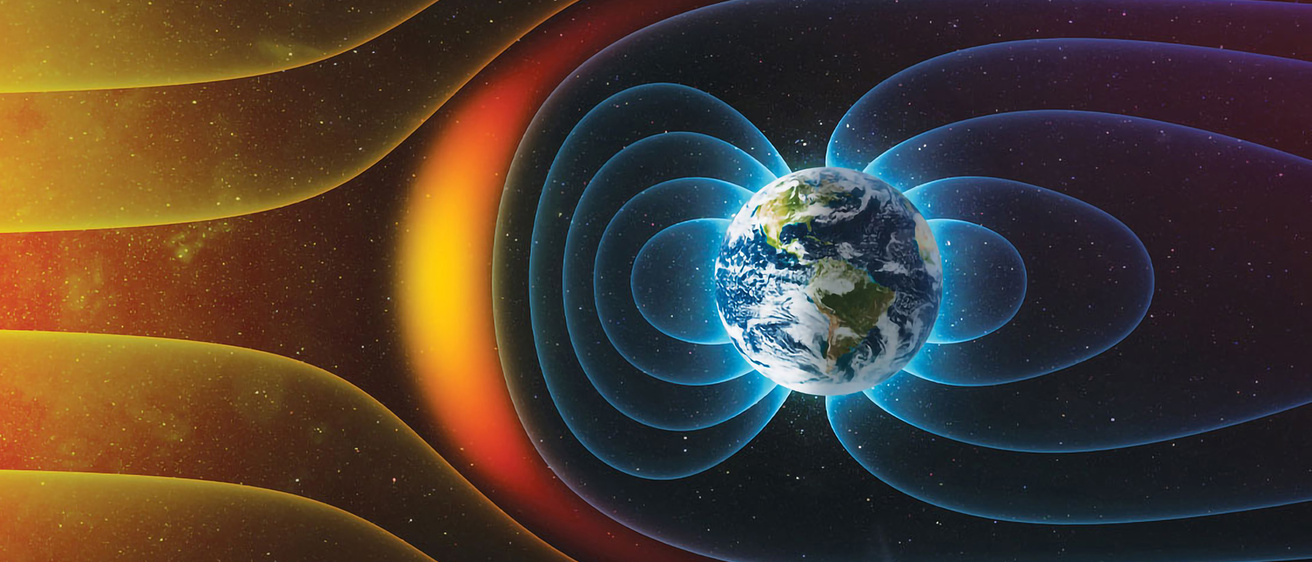With the TRACERS launch in the books, take a trip through the timeline of the university’s largest externally funded research project, which will examine the powerful interactions between the magnetic fields of the sun and Earth.
Story: Richard C. Lewis
Photography and illustrations: Tim Schoon, Millennium Space Systems, the UI Department of Physics and Astronomy, and NASA
Videography: David Scrivner
Published: July 16, 2025 (last updated July 23, 2025)
In October 2017, Craig Kletzing formally proposed an idea.
Kletzing, an experimental space physicist who for most of his career had been awed by the complexities surrounding auroras, petitioned NASA to fund an ambitious plan to study when and why the magnetic bubble surrounding Earth sometimes doesn’t fully repel the supersonic, heated winds from the sun, which can threaten satellite and telecommunications activities on our planet.
Kletzing labeled his proposed mission Tandem Reconnection and Cusp Electrodynamics Reconnaissance Satellites, or TRACERS.
“TRACERS addresses long-standing questions about how energy couples from the solar wind into our local magnetosphere,” Kletzing, who died in August 2023 at age 65, described his idea. “One of the long-term goals is to evolve toward ‘space weather’ models to improve our ability to utilize space as a resource. TRACERS will be essential to achieve this goal.”
Nearly eight years later, the Iowa-led $165.7 million mission, the largest external research award in university history, is a reality. On July 23, 2025, a Falcon 9 rocket lifted off from Vandenberg Space Force Base in California carrying twin spacecraft loaded with instruments designed, built, or tested by Iowa’s expansive TRACERS team.
The two identical satellites will cross the Earth’s northern cusp, a funnel-shaped region where the Earth’s magnetic field concentrates near the North Pole. There, the twin spacecraft will sense a vast region of near-Earth space, where the magnetic fields of the Earth and sun collide.
When that happens, the magnetic fields either flow past each other or they connect, sparking powerful bursts of radiation and coupling energy into the Earth system that ultimately spawns the mesmerizing northern and southern lights but that also threaten activities and operations on Earth.
“TRACERS will reveal how the magnetic connection between the sun and the Earth evolves and fluctuates over time,” David Miles, associate professor in the Department of Physics and Astronomy at Iowa and the mission’s principal investigator, says. “Craig proved the scientific concept in 2018 when his team launched a pair of small suborbital rockets in the TRICE-2 mission. TRACERS is the equivalent of launching 3,000 pairs of rockets and will give us a comprehensive and detailed picture of how the solar wind connection to near-Earth space varies over time and solar wind conditions.”
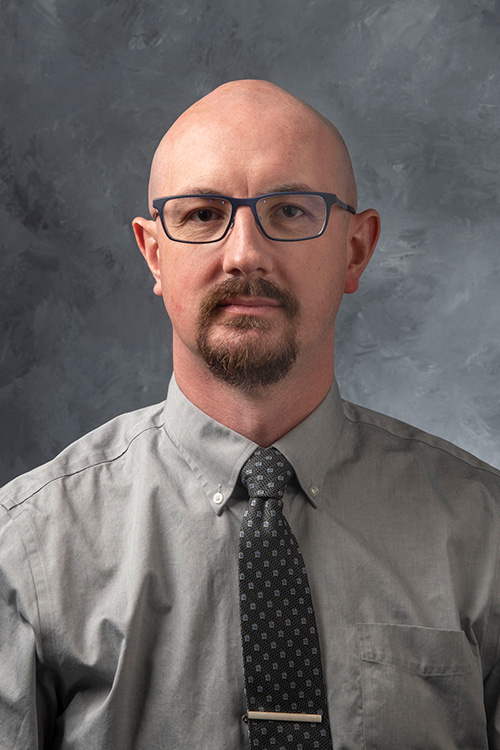
David Miles
More than 80 physicists, engineers, machinists, electronics and circuitry experts, research scientists, and support staff — from undergraduate students to tenured faculty — have been hired or employed by TRACERS to see the mission through. Many of them work in one of seven service centers operated by the Department of Physics and Astronomy that are open for business for campus partners.
Iowa has been the epicenter for TRACERS from the beginning. Two instruments — the Analyzer for Cusp Electrons, piloted by Professor Jasper Halekas, and the Magnetic Search Coil, led by research scientist George Hospodarsky — were fully designed and built at Iowa. (A third Iowa-created instrument, a prototype magnetometer called MAGIC, will accompany as a technology demonstration project.) Three other instruments from participating institutions UCLA; University of California, Berkeley; and the Southwest Research Institute were shipped to Iowa to undergo extensive testing by TRACERS professionals in Van Allen Hall.
The TRACERS launch is yet another Iowa-led mission in a nearly seven-decade continuum of excellence in space physics that started with the 1958 flight of James Van Allen’s cosmic ray instrument on the satellite Explorer 1, the first American-made instrument to make a scientific measurement in Earth orbit. Van Allen’s instrument discovered the harsh radiation environment encircling Earth; he was later honored by having the radiation belts named after him.
Van Allen’s instrument was not the only one with UI connections to achieve distinction: Iowa scientists have designed and built instruments on humankind’s first flights to all the planets in our solar system, yielding seminal discoveries about radiation belts around other planets, lightning on Jupiter and Saturn, magnetic fields on planetary moons, and marking the boundary between the solar system and interstellar space.
TRACERS is the next in line to make another discovery — and another milestone for Iowa space physics.
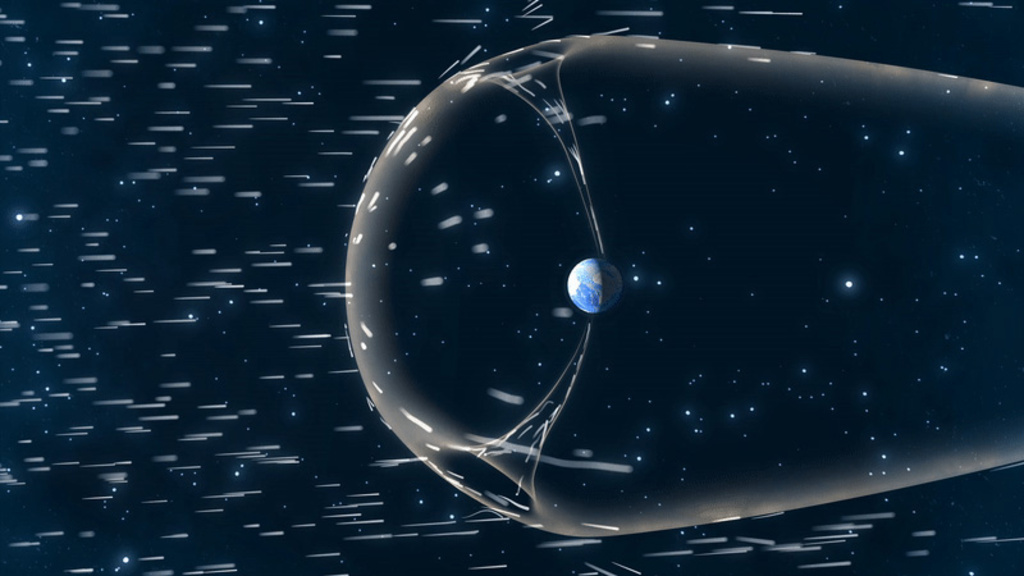
Why study space weather?
The solar wind, a stream of charged particles from the sun that carries the sun's magnetic field, interacts with Earth’s magnetic field, causing “space weather.”
When a solar flare (coronal mass ejection, or CME) sends charged particles from the sun to Earth, some of those charged particles interact with the local plasma within the Earth's magnetosphere. This cascading transfer of energy causes things like the northern and southern lights (auroras). Sometimes, especially due to larger CMEs, these events cause problems with our electrical infrastructure.
There is evidence of CMEs in the past that would be catastrophic to our current communications and guidance systems. One reason NASA and the University of Iowa aim to better understand the physical processes underlying space weather is to protect humanity from such events.
The TRACERS timeline

The TRACERS idea receives initial NASA funding
October 2017Craig Kletzing begins a two-year journey to fully develop the TRACERS mission concept after being awarded $1.25 million from NASA for his proposal to study the mysterious, powerful interactions between the magnetic fields of the sun and Earth. He would compete with four teams to be chosen to lead a mission under NASA’s Explorers Program.
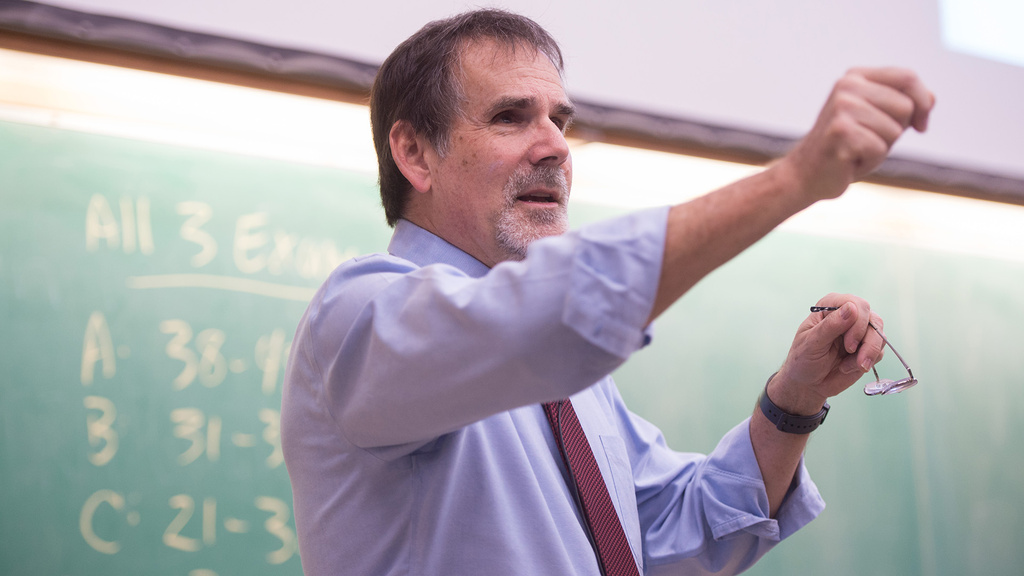
Kletzing wins record funding for TRACERS mission
June 2019NASA announces that the TRACERS proposal from Craig Kletzing, professor and physicist, will be fully funded. The award, the single largest externally funded research project in UI history, is the first to top more than $100 million (out of more than 35,000 funded research projects).
“This is a career milestone for me personally,” Kletzing says. “It’s also a fantastic opportunity to do some really great science with an all-star team.”

NASA chief visits University of Iowa
August 2019Jim Bridenstine, NASA’s top official at the time, visits the University of Iowa shortly after his agency awards university physicists the TRACERS mission, touring laboratories in Van Allen Hall to see UI research at work.
At a press conference, Bridenstine praises the university’s long-standing history in space research and its commitment to involving undergraduate and graduate students in space instrument design and building. “What happens here at the University of Iowa is going to be transformational for the future of human space flight and the human condition here on Earth,” he says.
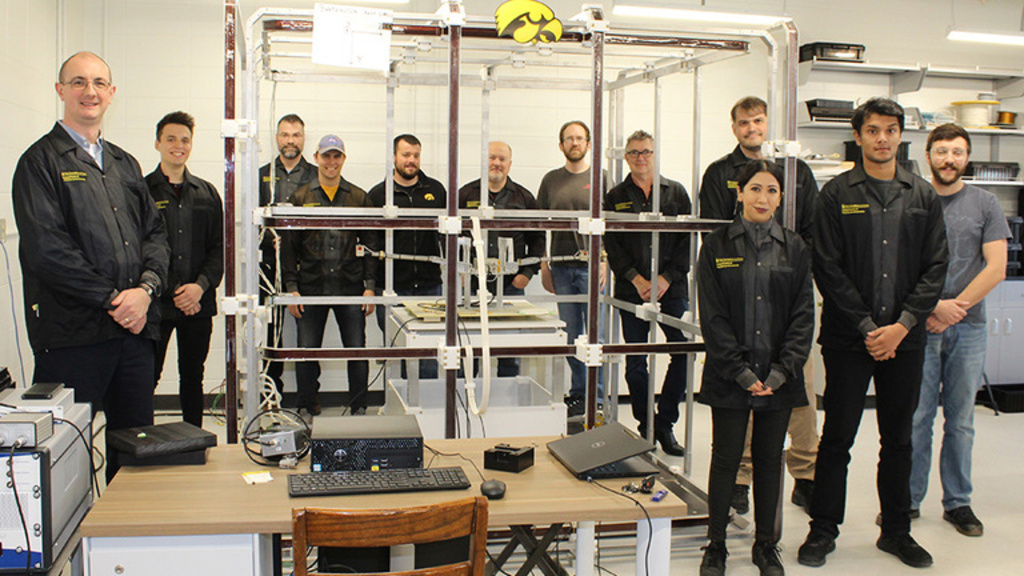
NASA gives TRACERS mission official ‘green light’
June 2020After meetings with NASA officials, Craig Kletzing, professor of physics and the principal investigator on TRACERS, announces that TRACERS has passed Key Decision Point B, meaning the mission has progressed from the concept phase to the design phase when all the details of the mission are developed prior to manufacturing.
NASA also allocates an additional $7.6 million to Iowa for a project, led by UI scientist David Miles, to design, build, and test a prototype magnetic-field instrument (MAGIC) to fly with TRACERS.
TRACERS mission passes critical NASA review
March 31, 2022NASA announces that TRACERS has passed a critical milestone in which the agency positively evaluated the mission’s design and project plan. The review, called Key Decision Point C, means scientists at Iowa and the partner institutions can begin to create the suite of scientific instruments and the two satellites.
“TRACERS will be an important addition to our heliophysics fleet,” Washito Sasamoto, program executive at the time for the mission at NASA Headquarters in Washington, D.C., said in a NASA statement. “The mission is targeting long-standing questions critical to understanding the sun-Earth system.”

Magnetic Search Coil instrument completed
Aug. 3, 2023TRACERS researchers complete building the Magnetic Search Coil instrument, one of six instruments that will fly on the NASA TRACERS mission to study the powerful interactions between the sun and the Earth. The instrument, led by George Hospodarsky, research scientist at Iowa, will measure magnetic field changes over time to better understand the specific points in space where energetic particles blasted from the sun interact with the Earth's upper atmosphere.
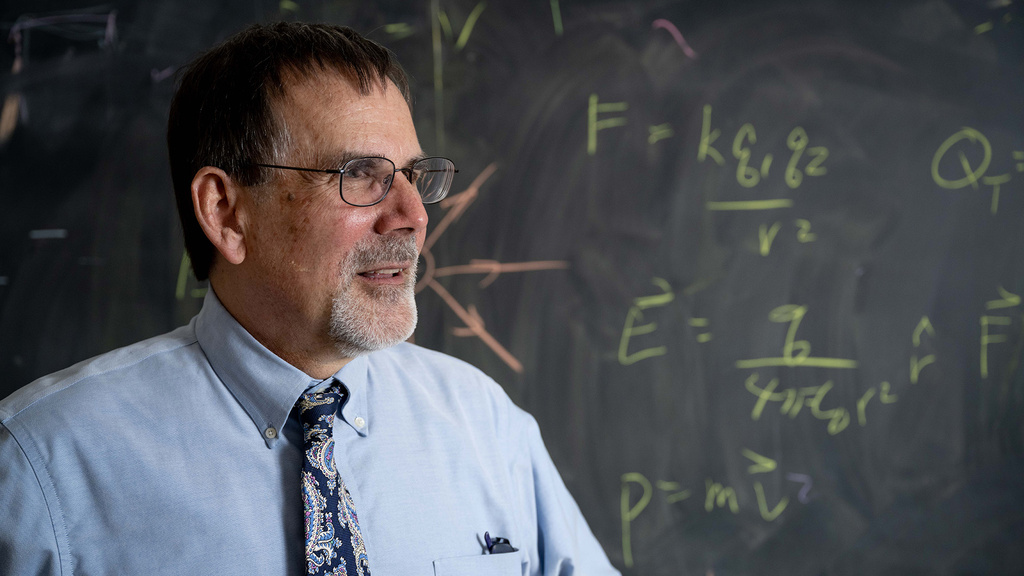
Craig Kletzing dies at 65
Aug. 10, 2023Craig Kletzing, the physicist who proposed the TRACERS mission to NASA, passes away at the age of 65. Kletzing combined a zeal for teaching with a decorated research career in space plasma experimental physics. His TRACERS award is the largest single externally funded research project in UI history.
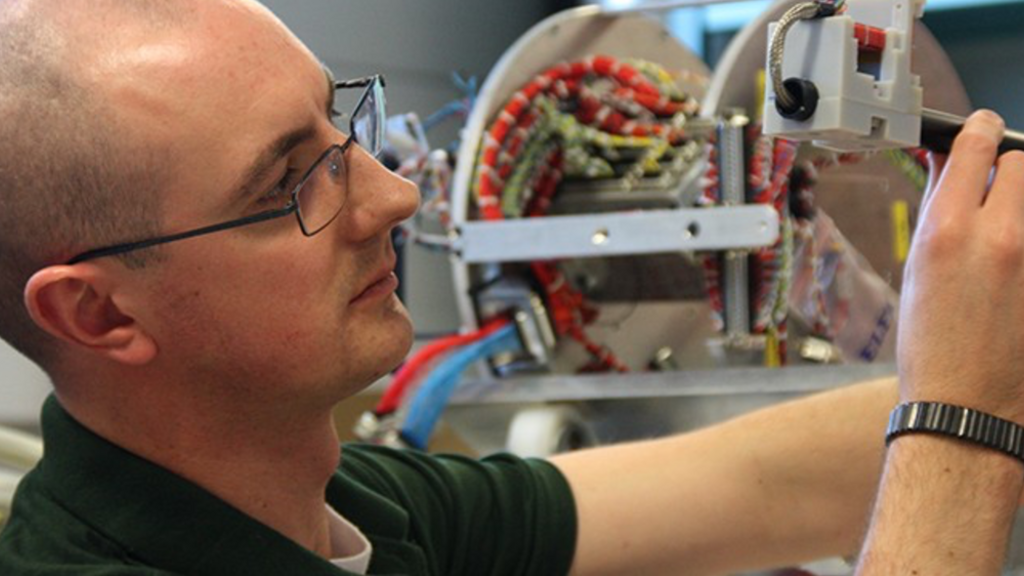
Miles named PI of TRACERS mission
September 2023NASA announces that David Miles, assistant (later associate) professor in the Department of Physics and Astronomy at the University of Iowa, has been named principal investigator of the TRACERS mission. Miles succeeds Craig Kletzing, who proposed the mission and died in August 2023 at the age of 65.

NASA officials visit University of Iowa for TRACERS briefing
March 7, 2024A delegation from NASA visits the University of Iowa to get an in-person briefing on the status of the university’s leadership in the TRACERS mission. The NASA group, led by Joe Westlake, head of the agency’s heliophysics division, learned about the progress UI scientists have made on the five TRACERS instruments that will determine how powerful winds from the sun are able to cleave through the Earth’s magnetic field and potentially affect satellites, telecommunications, and energy grids.
“I’m excited for this mission,” Westlake says.

Kletzing guitar pick embedded in main electronics box
April 19, 2024The TRACERS team at Iowa completes the main electronics box that will be the communications center for the six instruments outfitted for the NASA mission to study the powerful energetic interactions between the sun and the Earth. As a tribute to the passing of Iowa physicist Craig Kletzing, the team embeds a guitar pick that Kletzing used during his well-known jam band performances around Iowa City in each of the two electronics boxes.

ACE instruments completed
June 2024University of Iowa scientists complete the Analyzer for Cusp Electrons (ACE), an instrument designed and built at Iowa for the TRACERS mission. ACE will help determine the locations where the powerful jet of energy from the sun — known as the solar wind —interacts directly with Earth’s magnetic fields. Those special regions of interaction, known as cusps, are integral to understanding how the solar wind penetrates Earth’s magnetic fields, causing auroras but also capable of disrupting communications on our planet. Jasper Halekas, physics professor at Iowa, is ACE’s principal investigator.

TRACERS instrument suite packed and shipped
July 12, 2024All hands on deck! An army of University of Iowa TRACERS scientists and staff carefully wrap and pack the five instruments and a prototype magnetometer that constitute the scientific payload for the mission. The instrument assembly was loaded onto a truck and driven to Millennium Space Systems in California, where it will be added to the twin spacecraft being built by the Boeing subsidiary.
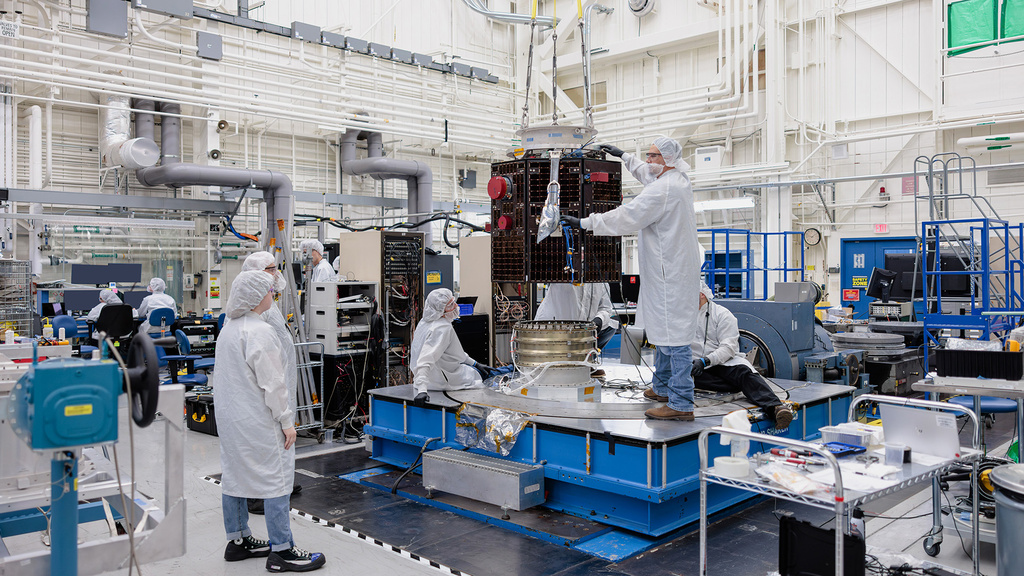
TRACERS instruments arrive at Millennium
July 15, 2024The instruments for the TRACERS mission, shipped from the University of Iowa, arrive at Millennium Space Systems. Millennium, a Boeing company, is building the two satellites that will fly the TRACERS instruments in space.
TRACERS clears another NASA checkpoint
Aug. 8, 2024NASA announces that the TRACERS mission has passed Key Decision Point D. The designation means NASA has authorized the mission to begin integrating the instruments and subsystems together and testing the completed spacecraft to ensure that they will perform in space.

Spacecraft completed for TRACERS
Nov. 12, 2024Millennium Space Systems announces that it has completed building the two spacecraft that will fly the TRACERS instruments. Next up for the integrated satellites and instruments: a series of tests over several months to ensure they are flight ready.

TRACERS showcased at AGU meeting
Dec. 9, 2024The University of Iowa puts on a TRACERS show at the annual American Geophysical Union meeting in Washington, D.C. Iowa scientists and staff host a booth at which they explain the mission concept, the instruments, and the science that the novel, historic mission will deliver.
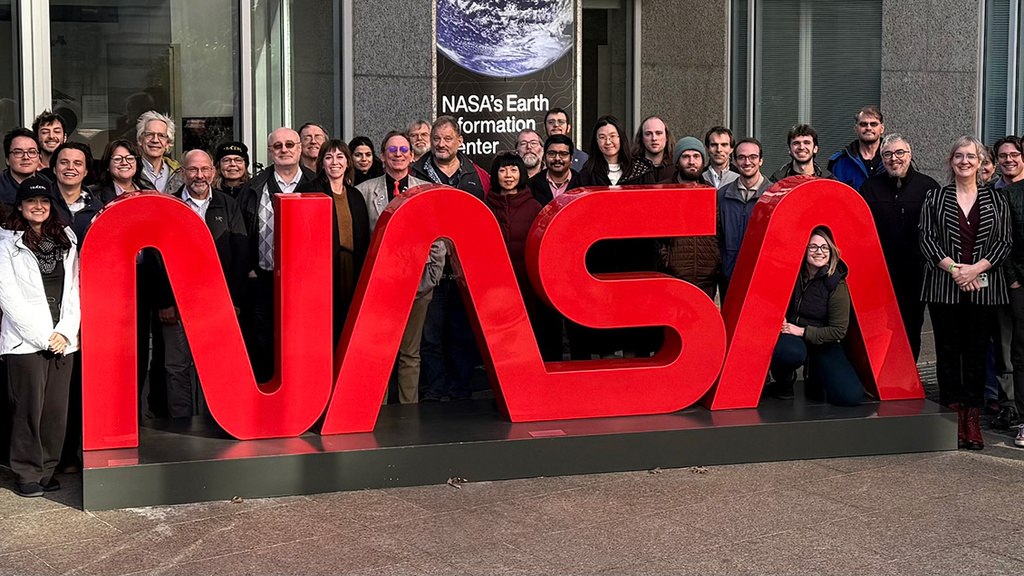
TRACERS science team holds meeting at NASA HQ
Dec. 14, 2024The University of Iowa-led TRACERS science team holds a meeting at NASA headquarters in Washington, D.C., planning how to analyze the vast volume of scientific data that will begin to flow once the satellites are launched.

TRACERS spacecraft shipped to launch site
June 13, 2025The TRACERS spacecraft and their instruments payload arrive at Vandenberg Space Force Base, their final destination before launch. The twin satellites were built at Millennium Space Systems; the instruments, shipped from Iowa to Millennium in July 2024, underwent more testing after they were attached to the spacecraft before shipping to Vandenberg.
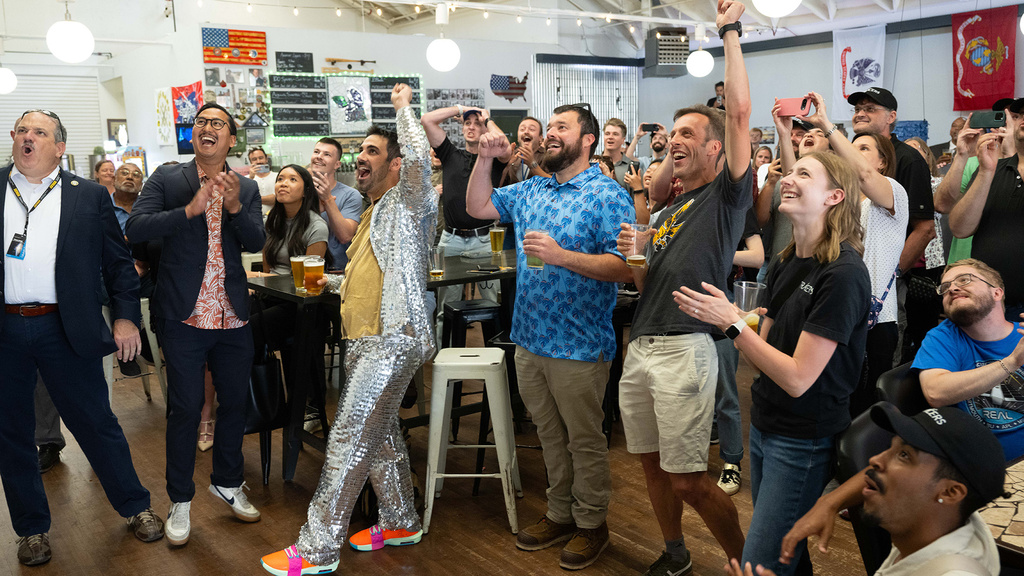
Iowa researchers celebrate TRACERS launch
July 23, 2025On July 23, 2025, at 11:13 a.m. PDT, a Falcon 9 rocket shot upward from Vandenberg Space Force Base in California, and the University of Iowa notched a significant milestone in space physics.
Dozens of scientists from the University of Iowa traveled to Lompoc, California, to joyfully witness the successful rocket launch associated with TRACERS — the NASA-funded mission to study the mysterious, powerful interactions between the magnetic fields of the sun and Earth.
“One of the long-term goals of our space research: to evolve toward predictive ‘space weather’ models to improve our ability to utilize space as a resource. The science that TRACERS studies will be essential to achieve this goal.”
